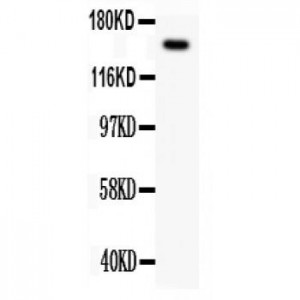More info
Overview
Long Name | Antibody Type | Antibody Isotype | Host | Species Reactivity | Validated Applications | Purification |
| MET proto-oncogene, receptor tyrosine kinase | Polyclonal | IgG | Rabbit | Human, Rat | WB | Immunogen affinity purified. |
Immunogen | ||||||
| E.coli-derived human Met recombinant protein (Position: D208-S407). Human Met shares 90% and 91% amino acid (aa) sequences identity with mouse and rat Met, respectively. | ||||||
Properties
Form | Lyophilized |
Size | 100 µg/vial |
Contents | Antibody is lyophilized with 5 mg BSA, 0.9 mg NaCl, 0.2 mg Na2HPO4, 0.05 mg NaN3. *carrier free antibody available upon request. |
Concentration | Reconstitute with 0.2 mL sterile dH2O (500 µg/ml final concentration). |
Storage | At -20 °C for 12 months, as supplied. Store reconstituted antibody at 2-8 °C for one month. For long-term storage, aliquot and store at -20 °C. Avoid repeated freezing and thawing. |
Additional Information Regarding the Antigen
Gene | MET |
Protein | Hepatocyte growth factor receptor |
Uniprot ID | P08581 |
Function | Receptor tyrosine kinase that transduces signals from the extracellular matrix into the cytoplasm by binding to hepatocyte growth factor/HGF ligand. Regulates many physiological processes including proliferation, scattering, morphogenesis and survival. Ligand binding at the cell surface induces autophosphorylation of MET on its intracellular domain that provides docking sites for downstream signaling molecules. Following activation by ligand, interacts with the PI3-kinase subunit PIK3R1, PLCG1, SRC, GRB2, STAT3 or the adapter GAB1. Recruitment of these downstream effectors by MET leads to the activation of several signaling cascades including the RAS-ERK, PI3 kinase-AKT, or PLCgamma-PKC. The RAS-ERK activation is associated with the morphogenetic effects while PI3K/AKT coordinates prosurvival effects. During embryonic development, MET signaling plays a role in gastrulation, development and migration of muscles and neuronal precursors, angiogenesis and kidney formation. In adults, participates in wound healing as well as organ regeneration and tissue remodeling. Promotes also differentiation and proliferation of hematopoietic cells. |
Tissue Specificity | Expressed in normal hepatocytes as well as in epithelial cells lining the stomach, the small and the large intestine. Found also in basal keratinocytes of esophagus and skin. High levels are found in liver, gastrointestinal tract, thyroid and kidney. Also present in the brain. |
Sub-cellular localization | Membrane; Single-pass type I membrane protein. |
Sequence Similarities | Belongs to the protein kinase superfamily. Tyr protein kinase family. |
Aliases | AUTS9 antibody|c met antibody|c met antibody|cmet antibody|cmet antibody|D249 antibody|Hepatocyte growth factor receptor antibody|Hepatocyte growth factor receptor Precursor antibody|Hepatocyte growth factor receptor Precursor antibody|HGF antibody|HGF receptor antibody|HGF receptor antibody|HGF SF receptor antibody|HGF SF receptor antibody|HGF/SF receptor antibody|HGFR antibody|MET antibody|Met proto oncogene tyrosine kinase antibody|Met proto oncogene tyrosine kinase antibody|MET proto oncogene, receptor tyrosine kinase antibody|Met proto-oncogene (hepatocyte growth factor receptor) antibody|Met proto-oncogene antibody|Met protooncogene antibody|MET_HUMAN antibody|Oncogene MET antibody|Oncogene MET antibody|Par4 antibody|Proto-oncogene c-Met antibody|RCCP2 antibody|Renal cell carcinoma papillary 2 gene antibody|Renal cell carcinoma papillary 2 gene antibody|Scatter factor receptor antibody|SF receptor antibody|Tyrosine-protein kinase Met antibody |
Application Details
| Application | Concentration* | Species | Validated Using** |
| Western blot | 0.1-0.5μg/ml | Rat Human | AssaySolutio's ECL kit |
AssaySolution recommends Rabbit Chemiluminescent WB Detection Kit (AKIT001B) for Western blot. *Blocking peptide can be purchased at $65. Contact us for more information
--antibody-ASA-B1268-1.jpg)
All lanes: Anti Met (c-Met) (ASA-B1268) at 0.5ug/ml
WB: Rat Liver Tissue Lysate at 50ug
Predicted bind size: 154KD
Observed bind size: 154KD
WB: Rat Liver Tissue Lysate at 50ug
Predicted bind size: 154KD
Observed bind size: 154KD
--antibody-ASA-B1268-2.jpg)


